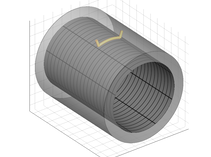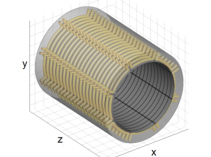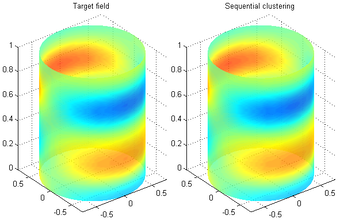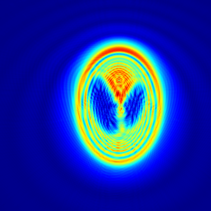Matrix gradients and customized shims
Rapid adaptive nonlinear gradient encoding (RANGE) is a new concept in magnetic resonance imaging (MRI) with the potential to greatly improve image quality and acquisition time. Instead of traditional spatial encoding with three linear encoding fields, the idea of RANGE is to use a gradient matrix coils with many independent coil elements. Such matrix coils appear to offer a high flexibility in generating customized spatial encoding fields and are particularly promising for localized high resolution imaging techniques.
Matrix coil approach can also be adapted to the magnetic field homogenization applications, so-called shimming. In contrast to the state of the art shimming, which is typically accomplished using lower-order spherical harmonic fields, matrix (or multi-coil) shimming uses drastically increased number of compact low-power coil elements to achieve unprecedented field correction performance. The accompanying challenge of handling the increased number of amplifiers, filters and cables is addressed by us the the mrSANE project (magnetic resonance shimming applications with near-magnet equipment), funded by the European Research Council.
The project covers all aspects from coil design and manufacturing, control electronics, encoding strategies and reconstruction.
Drive electronics
Many electronic components are needed to control the additional hardware and seamlessly integrate these with a clinical scanner. Main components are:
- Multi-channel current waveform generator
- Gradient and shim power amplifier design and development
- Multi-channel digital receiver design and development
- Clock distribution circuit
- Scalable MRI console design and development
Design of integrated shim power amplifiers, which can be placed in the immediate vicinity of the magnet has been a topic of the mrSANE project supported by the European Research Council as a part of the proof-of-concept initiative for the completed ERC-funded projects.
A target nonlinear encoding field can be achieved with a matrix coil with 11 amplifiers given an appropriate switching circuit.
Novel encoding strategies
The possibilities for spatial encoding are greatly expanded with the use of a matrix coil. The coil can be driven with fewer amplifiers than coil elements by dynamically switching combinations of elements together. We have shown that arbitrary nonlinear encoding fields can be achieved with high accuracy by optimising the switching circuit.
Image reconstruction
Online image reconstruction is achieved through a dedicated server equipped with a graphics processor unit (GPU). A fast conjugate gradient algorithm is implemented in CUDA for maximum performance. The custom reconstruction server is integrated to a hardware independent console with near real-time image display.
Pulseq: Vendor-independent sequence programming for MRI
The Pulseq project is a open source framework for the rapid development of NMR and MRI pulse sequences. A novel file format has been developed to allow sequences to be described in a compact and open manner. These sequence files can be executed on real scanner hardware. Current implementations exist for Siemens, Bruker and custom gradient hardware. See the Pulseq homepage for more details and the latest source code.
Phase scrambling
Another project considers the Parallel Imaging with Phase Scrambling (PIPS) technique which uses quadratic gradients to spread the signals in k-space. Image reconstruction can then be expressed as an inverse Fresnel transform, which, interpreted as a convolution with a properly windowed chirp kernel, allows aliasing free low-resolution reconstruction of undersampled data. Using these low-resolution images for estimation use of the coil sensitivities or GRAPPA kernels allows calibrationless parallel imaging.
2011
- Andrews-Shigaki, B. C., B. S. Armstrong, M. Zaitsev and T. Ernst (2011). "Prospective motion correction for magnetic resonance spectroscopy using single camera retro-grate reflector optical tracking." J Magn Reson Imaging 33(2): 498-504.
- Zahneisen, B., T. Grotz, K. J. Lee, S. Ohlendorf, M. Reisert, M. Zaitsev and J. Hennig (2011). "Three-dimensional MR-encephalography: Fast volumetric brain imaging using rosette trajectories." Magn Reson Med.
2010
- Ajraoui, S., K. J. Lee, M. H. Deppe, S. R. Parnell, J. Parra-Robles and J. M. Wild (2010). "Compressed sensing in hyperpolarized 3He Lung MRI." Magnetic Resonance in Medicine 63(4): 1059-1069.*
- Boegle, R., J. Maclaren and M. Zaitsev (2010). "Combining prospective motion correction and distortion correction for EPI: towards a comprehensive correction of motion and susceptibility-induced artifacts." Magnetic Resonance Materials in Physics, Biology and Medicine 23(4): 263-273.
- Deppe, M. H., K. Teh, J. Parra-Robles, K. J. Lee and J. M. Wild (2010). "Slice profile effects in 2D slice-selective MRI of hyperpolarized nuclei." J Magn Reson 202(2): 180-189.*
- Feinberg, D. A., D. Giese, D. A. Bongers, S. Ramanna, M. Zaitsev, M. Markl and M. Gunther (2010). "Hybrid ultrasound MRI for improved cardiac imaging and real-time respiration control." Magn Reson Med 63(2): 290-6.
- Gallichan, D., J. L. R. Andersson, M. Jenkinson, M. D. Robson and K. L. Miller (2010). "Reducing distortions in diffusion-weighted echo planar imaging with a dual-echo blip-reversed sequence." Magnetic Resonance in Medicine 64(2): 382-390.*
- Gallichan, D., J. Scholz, A. Bartsch, T. E. Behrens, M. D. Robson and K. L. Miller (2010). "Addressing a systematic vibration artifact in diffusion-weighted MRI." Hum Brain Mapp 31(2): 193-202.
- Lee, K. J., B. Zahneisen, J. Hennig, M. Weigel and J. Leupold (2010). "Multiplex RARE: a simultaneous multislice spin-echo sequence that fulfils CPMG conditions." Magn Reson Med 64(1): 299-305.
- Maclaren, J., O. Speck, D. Stucht, P. Schulze, J. Hennig and M. Zaitsev (2010). "Navigator accuracy requirements for prospective motion correction." Magn Reson Med 63(1): 162-70.
- Mager, D., A. Peter, L. D. Tin, E. Fischer, P. J. Smith, J. Hennig and J. G. Korvink (2010). "An MRI receiver coil produced by inkjet printing directly on to a flexible substrate." IEEE Trans Med Imaging 29(2): 482-7.
- McNab, J. A., D. Gallichan and K. L. Miller (2010). "3D steady-state diffusion-weighted imaging with trajectory using radially batched internal navigator echoes (TURBINE)." Magnetic Resonance in Medicine 63(1): 235-242.*
- Rick, J., O. Speck, S. Mayer, O. Tüscher, O. Dössel, J. Hennig and M. Zaitsev (2010). "Optimized EPI for fMRI using a slice-dependent templatebased gradient compensation method to recover local susceptibility-induced signal loss." Magn Reson Mater Phy 23(3): 165-176.
- Schultz, G. and K. Mombaur (2010). "Modeling and Optimal Control of Human-Like Running." Mechatronics, IEEE/ASME Transactions on 15(5): 783-792.*
- Schultz, G., P. Ullmann, H. Lehr, A. M. Welz, J. Hennig and M. Zaitsev (2010). "Reconstruction of MRI data encoded with arbitrarily shaped, curvilinear, nonbijective magnetic fields." Magnetic Resonance in Medicine 64(5): 1390-1403.
- Snyder, J., R. B. Thompson and A. H. Wilman (2010). "Difference spectroscopy using PRESS asymmetry: application to glutamate, glutamine, and myo-inositol." NMR Biomed 23(1): 41-47.*
- Snyder, J. and A. Wilman (2010). "Field strength dependence of PRESS timings for simultaneous detection of glutamate and glutamine from 1.5 to 7 T." Journal of Magnetic Resonance 203(1): 66-72.*
- Testud, F., D. N. Splitthoff, O. Speck, J. Hennig and M. Zaitsev (2010). "Direct magnetic field estimation based on echo planar raw data." IEEE Trans Med Imaging 29(7): 1401-11.
- Weber, H., D. Paul, D. V. Elverfeldt, J. Hennig and M. Zaitsev (2010). "Extended multi-flip-angle B1 mapping: A 3D mapping method for inhomogeneous B1 fields." Concepts in Magnetic Resonance Part B: Magnetic Resonance Engineering 37B(4): 203-214.
- Zaitsev, M., O. Speck, J. Hennig and M. Buchert (2010). "Single-voxel MRS with prospective motion correction and retrospective frequency correction." NMR Biomed 23(3): 325-32.
2009
- Deppe, M. H., K. Teh, J. Parra-Robles, K. J. Lee and J. M. Wild (2009). "Slice profile effects in 2D slice-selective MRI of hyperpolarized nuclei." J Magn Reson.*
- Dragonu, I., P. L. de Oliveira, C. Laurent, C. Mougenot, N. Grenier, C. T. Moonen and B. Quesson (2009). "Non-invasive determination of tissue thermal parameters from high intensity focused ultrasound treatment monitored by volumetric MRI thermometry." NMR Biomed.*
- Dragonu, I., B. D. de Senneville, B. Quesson, C. Moonen and M. Ries (2009). "Real-time geometric distortion correction for interventional imaging with echo-planar imaging (EPI)." Magn Reson Med 61(4): 994-1000.*
- Fischer, E., C. Navarro, H. Sommer, D. Benczédi, M. I. Velazco and M. Schönhoff (2009). "Partitioning and localization of fragrances in surfactant mixed micelles." Journal of Surfactants and Detergents 12: 73-84.*
- Gallichan, D., M. D. Robson, A. Bartsch and K. L. Miller (2009). "TREMR: Table-resonance elastography with MR." Magn Reson Med.*
- Gallichan, D., J. Scholz, A. Bartsch, T. E. Behrens, M. D. Robson and K. L. Miller (2009). "Addressing a systematic vibration artifact in diffusion-weighted MRI." Hum Brain Mapp.*
- Grotz, T., B. Zahneisen, A. Ella, M. Zaitsev and J. Hennig (2009). "Fast Functional Brain Imaging Using Constrained Reconstruction Based on Regularization Using Arbitrary Projections." Magn Reson Med 62(2): 394-405.
- Herrmann, M., M. Haas, U. D. Jentschura, F. Kottmann, D. Leibfried, G. Saathoff, C. Gohle, A. Ozawa, V. Batteiger, S. Knünz, N. Kolachevsky, H. Schüssler, T. W. Hänsch and T. Udem (2009). "The 1S-2S transition in singly ionized helium: Feasibility of high-precision spectroscopy in the XUV." Physical Review A 79(5): 05250/1 bis 05250/15.*
- Herrmann, M., M. Haas, U. D. Jentschura, F. Kottmann, D. Leibfried, G. Saathoff, C. Gohle, A. Ozawa, V. Batteiger, S. Knunz, N. Kolachevsky, H. A. Schussler, T. W. Hansch and T. Udem (2009). ""Feasibility of coherent xuv spectroscopy on the 1S-2S transition in singly ionized helium." Physical Review A 79(5): 15.*
- Nagaraja, S., Q. Ullah, K. J. Lee, I. Bickle, L. Q. Hon, P. D. Griffiths, A. Raghavan, P. Flynn and D. J. A. Connolly (2009). "Discrepancy in reporting among specialist registrars and the role of a paediatric neuroradiologist in reporting paediatric CT head examinations." Clin Radiol 64(9): 891-6.*
- Paul, D. and M. Zaitsev (2009). "Improved SNR in linear reordered 2D bSSFP imaging using variable flip angles." Magn Reson Imaging.*
- Paul, D., M. Zaitsev, L. Harsan, A. Kurutsch, D. N. Splitthoff, F. Hennel, M. Choli and D. von Elverfeldt (2009). "Implementation and application of PSF-based EPI distortion correction to high field animal imaging." Int J Biomed Imaging 2009: 946271.
- Snyder, J., C. C. Hanstock and A. H. Wilman (2009). "Spectral editing of weakly coupled spins using variable flip angles in PRESS constant echo time difference spectroscopy: application to GABA." J Magn Reson 200(2): 245-50.*
- Snyder, J., R. B. Thompson and A. H. Wilman (2009). "Difference spectroscopy using PRESS asymmetry: application to glutamate, glutamine, and myo-inositol." NMR Biomed.*
- Splitthoff, D. N. and M. Zaitsev (2009). "SENSE shimming (SSH): A fast approach for determining B(0) field inhomogeneities using sensitivity coding." Magn Reson Med 62(5): 1319-25.
- Tourdias, T., I. Dragonu, Y. Fushimi, M. S. Deloire, C. Boiziau, B. Brochet, C. Moonen, K. G. Petry and V. Dousset (2009). "Aquaporin 4 correlates with apparent diffusion coefficient and hydrocephalus severity in the rat brain: a combined MRI-histological study." Neuroimage 47(2): 659-66.*
- Yoon, C. H., B. Bodvarsson, S. Klim, M. Morkebjerg, S. Mortensen, J. Chen, J. R. Maclaren, P. K. Luther, J. M. Squire, P. J. Bones and R. P. Millane (2009). "Determination of myosin filament orientations in electron micrographs of muscle cross sections." IEEE Trans Image Process 18(4): 831-9.*
- Zhou, K., M. Zaitsev and S. Bao (2009). "Reliable two-dimensional phase unwrapping method using region growing and local linear estimation." Magn Reson Med.
2008
- Hennig, J., A. Welz, G. Schulz, J. Korvink, Z. Liu, O.Speck, M. Zaitsev (2008). "Parallel imaging in non-bijective, curvilinear magnetic field gradients: a concept study." Magn Reson Mater Phy 21(1-2): 5-14.
- Maclaren, J. R., P. J. Bones, RP. Millane, R. Wattes (2008)*. "MRI with TRELLIS: a novel approach to motion correction." Magn Reson Imaging 26(4): 474-83.
- Speck, O., J. Stadler, Zaitsev, M. (2008). "High resolution single-shot EPI at 7T." Magma 21(1-2): 73-86.
- Hennig, J. et al. (2008). "Ultra high field MR: useful instruments or toys for the boys." Magn Reson Mater Phy 21(1-2): 1-3.
2007
- Weigel, M., M. Zaitsev, Hennig, J. (2007). "Inversion recovery prepared turbo spin echo sequences with reduced SAR using smooth transitions between pseudo steady states." Magn Reson Med 57(3): 631-7.
* is not related to the INUMAC project
Dr. Sebastian Littin
Group Leader
Tel.: +49 761 270-93820
E-Mail: sebastian.littin@uniklinik-freiburg.de
University Medical Center Freiburg
Dept. of Radiology · Medical Physics
Killianstr. 5a
79106 Freiburg








